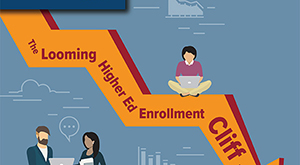A New Normal for Higher Ed

The campus is alive with all the startup activities of the fall semester. New freshmen and transfer students have begun to find their way around campus, and returning students have unloaded all the stuff they had packed into their parents’ basements during the summer. A celebratory opening convocation preceded the first day of classes to welcome the new students and connect them to some of the traditions that make the college special. The semester begins, and just five days later, the president calls and asks you to come to a meeting that begins in 30 minutes.
The first reports from the registrar’s office confirm that the institution has missed its enrollment target by more than 100 students. It also missed enrollment targets for the last two years and had to dip into already limited reserves to balance the budget. This cannot be the solution for this year.
Help me finish the scenario from here:
- The academic year budget must be reduced by $2 million. There is no plan for addressing the deficit. Everyone had crossed their fingers and hoped that admissions would “come through” to fill the new class and that a “higher than normal” percentage of students would return. You have been called into the president’s office with 10 others to determine the actions that need to be taken immediately. Everyone in the room has a different opinion regarding how to proceed … some with clear agendas that protect their turf. A plan is thrown together that needs to be implemented within 48 hours. [A variation to this scenario is that you were not one of the 10 included in the meeting, but were instead called 24 hours after the meeting and told what HR needs to do make this happen. Those included in the meeting spent the first 24 hours talking to each other.]
- The budget must be reduced by $2 million. Last year, you worked with the president and others to develop a plan should this likely enrollment deficit occur again this year. The leadership team determined the two programs that will need to be eliminated. Key members of the board were also advised. Severance packages for impacted employees have already been determined, and a thoughtful communications plan has already been developed to share the news with the impacted employees, the campus community and the local media. The difficult process begins in accordance with the timeline that had already been established.
- Based on the trend of the last couple of years, a budget was created and approved last year anticipating a potential decrease in students. Necessary but painful discussions were held last December and January to give faculty and staff the opportunity to help identify areas of cost savings and the programs and services that are core to the learning, development and retention of our students. The changes you and your colleagues had to communicate last April were difficult, but they helped position the college for a new normal with fewer students.
I am sure you could add other scenarios, but the bottom line is that many of our institutions are facing the challenge of the “new normal” as the number of traditional college-aged students continues to shrink as we approach the 2025 higher ed enrollment cliff. With low unemployment in most parts of the country, some high school graduates who a decade ago might have continued their education are instead choosing to go directly into the workforce. Low unemployment is also impacting the number of non-traditional students seeking additional academic credentials.
Over the last several months, the CUPA-HR national and regional board members have discussed the enrollment cliff challenges with their enrollment management colleagues and other campus leaders. Based on these discussions and our collective work, we have developed some important recommended actions for higher ed HR leaders to take to help prepare for not just the 2025 enrollment cliff, but the significant challenges of our institutions now and into the future. Some of this information is included in the cover article of the new issue of Higher Ed HR Magazine.
I encourage you to act now to help other campus leaders prepare, and to help ensure the actions that impact employees are carefully and thoughtfully planned and implemented.
Read the new issue of Higher Ed HR Magazine, which contains several articles on how HR can contribute to student success.


